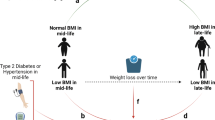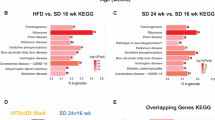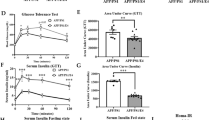Abstract
Accumulating studies suggest that overnutrition-associated obesity may lead to development of type 2 diabetes mellitus and metabolic syndromes (MetS). MetS and its components are important risk factors of mild cognitive impairment, age-related cognitive decline, vascular dementia, and Alzheimer’s disease. It has been recently proposed that development of a disease-course modification strategy toward early and effective risk factor management would be clinically significant in reducing the risk of metabolic disorder-initiated cognitive decline. In the present study, we propose that fibroblast growth factor 21 (FGF21) is a novel candidate for the disease-course modification approach. Using a high-fat diet (HFD) consumption-induced obese mouse model, we tested our hypothesis that recombinant human FGF21 (rFGF21) administration is effective for improving obesity-induced cognitive dysfunction and anxiety-like behavior, by its multiple metabolic modulation and anti-pro-inflammation actions. Our experimental findings support our hypothesis that rFGF21 is protective to HFD-induced cognitive impairment, at least in part by metabolic regulation in glucose tolerance impairment, insulin resistance, and hyperlipidemia; potent systemic pro-inflammation inhibition; and improvement of hippocampal dysfunction, particularly by inhibiting pro-neuroinflammation and neurogenesis deficit. This study suggests that FGF21 might be a novel molecular target of the disease-course-modifying strategy for early intervention of MstS-associated cognitive decline.








Similar content being viewed by others
Abbreviations
- Akt:
-
Protein kinase B
- BBB:
-
Blood-brain barrier
- BDNF:
-
Brain-derived neurotrophic factor
- DCX:
-
Doublecortin
- DG:
-
Dentate gyrus
- FGF21:
-
Fibroblast growth factor 21
- FGFR1:
-
Fibroblast growth factor receptor 1
- GSK-3β:
-
Glycogen synthase kinase 3 beta
- GTT:
-
Glucose tolerance test
- HbA1c:
-
Glycated hemoglobin
- HDL:
-
High-density lipoproteins
- HFD:
-
High-fat diet
- Iba1:
-
Ionized calcium binding adaptor molecule 1
- IGF-1:
-
Insulin-like growth factor-1
- IL-1β:
-
Interleukin 1 beta
- IL-6:
-
Interleukin 6
- i.p.:
-
Intraperitoneal injection
- ITT:
-
Insulin tolerance test
- LDL:
-
Low-density lipoproteins
- MetS:
-
Metabolic syndrome
- MHCII:
-
Major histocompatibility complex class II
- PCR:
-
Polymerase chain reaction
- PSD95:
-
Postsynaptic density protein 95
- rFGF21:
-
Recombinant human fibroblast growth factor 21
- RI:
-
Recognition index
- SD:
-
Standard diet
- SEM:
-
Standard error of the mean
- TC:
-
Total cholesterol
- TG:
-
Triglycerides
- TNFα:
-
Tumor necrosis factor alpha
- WAT:
-
White adipose tissue
References
Mandviwala T, Khalid U, Deswal A (2016) Obesity and cardiovascular disease: a risk factor or a risk marker? Curr Atheroscler Rep 18:21. doi:10.1007/s11883-016-0575-4
Goran MI, Alderete TL (2012) Targeting adipose tissue inflammation to treat the underlying basis of the metabolic complications of obesity. Nestle Nutr Inst Workshop Ser 73:49–60; discussion p61–6. doi:10.1159/000341287
Verma S, Hussain ME (2016) Obesity and diabetes: an update. Diabetes Metab Syndr. doi:10.1016/j.dsx.2016.06.017
Frisardi V, Solfrizzi V, Capurso C, Imbimbo BP, Vendemiale G, Seripa D, Pilotto A, Panza F (2010) Is insulin resistant brain state a central feature of the metabolic-cognitive syndrome? J Alzheimers Dis 21:57–63. doi:10.3233/JAD-2010-100015
Pedditizi E, Peters R, Beckett N (2016) The risk of overweight/obesity in mid-life and late life for the development of dementia: a systematic review and meta-analysis of longitudinal studies. Age Ageing 45:14–21. doi:10.1093/ageing/afv151
Panza F, Frisardi V, Seripa D, Imbimbo BP, Sancarlo D, D’Onofrio G, Addante F, Paris F et al (2011) Metabolic syndrome, mild cognitive impairment, and dementia. Curr Alzheimer Res 8:492–509
Stoeckel LE, Arvanitakis Z, Gandy S, Small D, Kahn CR, Pascual-Leone A, Pawlyk A, Sherwin R et al (2016) Complex mechanisms linking neurocognitive dysfunction to insulin resistance and other metabolic dysfunction. F1000Res 5:353. doi:10.12688/f1000research.8300.2
Lamport DJ, Lawton CL, Mansfield MW, Dye L (2009) Impairments in glucose tolerance can have a negative impact on cognitive function: a systematic research review. Neurosci Biobehav Rev 33:394–413. doi:10.1016/j.neubiorev.2008.10.008
Miller AA, Spencer SJ (2014) Obesity and neuroinflammation: a pathway to cognitive impairment. Brain Behav Immun 42:10–21. doi:10.1016/j.bbi.2014.04.001
Stranahan AM (2015) Models and mechanisms for hippocampal dysfunction in obesity and diabetes. Neuroscience 309:125–139. doi:10.1016/j.neuroscience.2015.04.045
Saltiel AR, Olefsky JM (2017) Inflammatory mechanisms linking obesity and metabolic disease. J Clin Invest 127:1–4. doi:10.1172/JCI92035
Calvo-Ochoa E, Arias C (2015) Cellular and metabolic alterations in the hippocampus caused by insulin signalling dysfunction and its association with cognitive impairment during aging and Alzheimer’s disease: studies in animal models. Diabetes Metab Res Rev 31:1–13. doi:10.1002/dmrr.2531
Castanon N, Luheshi G, Laye S (2015) Role of neuroinflammation in the emotional and cognitive alterations displayed by animal models of obesity. Front Neurosci 9:229. doi:10.3389/fnins.2015.00229
Panza F, Frisardi V, Capurso C, Imbimbo BP, Vendemiale G, Santamato A, D’Onofrio G, Seripa D et al (2010) Metabolic syndrome and cognitive impairment: current epidemiology and possible underlying mechanisms. J Alzheimers Dis 21:691–724. doi:10.3233/JAD-2010-091669
Beenken A, Mohammadi M (2009) The FGF family: biology, pathophysiology and therapy. Nat Rev Drug Discov 8:235–253. doi:10.1038/nrd2792
Katoh M, Nakagama H (2014) FGF receptors: cancer biology and therapeutics. Med Res Rev 34:280–300. doi:10.1002/med.21288
Markan KR, Potthoff MJ (2016) Metabolic fibroblast growth factors (FGFs): mediators of energy homeostasis. Semin Cell Dev Biol 53:85–93. doi:10.1016/j.semcdb.2015.09.021
Nies VJ, Sancar G, Liu W, van Zutphen T, Struik D, Yu RT, Atkins AR, Evans RM et al (2015) Fibroblast growth factor signaling in metabolic regulation. Front Endocrinol (Lausanne) 6:193. doi:10.3389/fendo.2015.00193
Woo YC, Xu A, Wang Y, Lam KS (2013) Fibroblast growth factor 21 as an emerging metabolic regulator: clinical perspectives. Clin Endocrinol 78:489–496. doi:10.1111/cen.12095
Murata Y, Konishi M, Itoh N (2011) FGF21 as an endocrine regulator in lipid metabolism: from molecular evolution to physiology and pathophysiology. J Nutr Metab 2011:981315. doi:10.1155/2011/981315
Hsuchou H, Pan W, Kastin AJ (2007) The fasting polypeptide FGF21 can enter brain from blood. Peptides 28:2382–2386. doi:10.1016/j.peptides.2007.10.007
Kim KH, Lee MS (2014) FGF21 as a stress hormone: the roles of FGF21 in stress adaptation and the treatment of metabolic diseases. Diabetes Metab J 38:245–251. doi:10.4093/dmj.2014.38.4.245
Kharitonenkov A, DiMarchi R (2015) FGF21 revolutions: recent advances illuminating FGF21 biology and medicinal properties. Trends Endocrinol Metab 26:608–617. doi:10.1016/j.tem.2015.09.007
Gaich G, Chien JY, Fu H, Glass LC, Deeg MA, Holland WL, Kharitonenkov A, Bumol T et al (2013) The effects of LY2405319, an FGF21 analog, in obese human subjects with type 2 diabetes. Cell Metab 18:333–340. doi:10.1016/j.cmet.2013.08.005
Zhang J, Li Y (2015) Fibroblast growth factor 21 analogs for treating metabolic disorders. Front Endocrinol (Lausanne) 6:168. doi:10.3389/fendo.2015.00168
Kim KH, Lee MS (2015) FGF21 as a mediator of adaptive responses to stress and metabolic benefits of anti-diabetic drugs. J Endocrinol 226:R1–16. doi:10.1530/JOE-15-0160
Planavila A, Redondo-Angulo I, Villarroya F (2015) FGF21 and cardiac physiopathology. Front Endocrinol (Lausanne) 6:133. doi:10.3389/fendo.2015.00133
Xu J, Stanislaus S, Chinookoswong N, Lau YY, Hager T, Patel J, Ge H, Weiszmann J et al (2009) Acute glucose-lowering and insulin-sensitizing action of FGF21 in insulin-resistant mouse models—association with liver and adipose tissue effects. Am J Physiol Endocrinol Metab 297:E1105–E1114. doi:10.1152/ajpendo.00348.2009
Li SM, Yu YH, Li L, Wang WF, Li DS (2015) Treatment of CIA mice with FGF21 down-regulates TH17-IL-17 axis. Inflammation. doi:10.1007/s10753-015-0251-9
Singhal G, Fisher FM, Chee MJ, Tan TG, El Ouaamari A, Adams AC, Najarian R, Kulkarni RN et al (2016) Fibroblast growth factor 21 (FGF21) protects against high fat diet induced inflammation and islet hyperplasia in pancreas. PLoS One 11:e0148252. doi:10.1371/journal.pone.0148252
Yu Y, Bai F, Wang W, Liu Y, Yuan Q, Qu S, Zhang T, Tian G et al (2015) Fibroblast growth factor 21 protects mouse brain against d-galactose induced aging via suppression of oxidative stress response and advanced glycation end products formation. Pharmacol Biochem Behav 133:122–131. doi:10.1016/j.pbb.2015.03.020
Planavila A, Redondo-Angulo I, Ribas F, Garrabou G, Casademont J, Giralt M, Villarroya F (2015) Fibroblast growth factor 21 protects the heart from oxidative stress. Cardiovasc Res 106:19–31. doi:10.1093/cvr/cvu263
Joki Y, Ohashi K, Yuasa D, Shibata R, Ito M, Matsuo K, Kambara T, Uemura Y et al (2015) FGF21 attenuates pathological myocardial remodeling following myocardial infarction through the adiponectin-dependent mechanism. Biochem Biophys Res Commun 459:124–130. doi:10.1016/j.bbrc.2015.02.081
Tanajak P, Chattipakorn SC, Chattipakorn N (2015) Effects of fibroblast growth factor 21 on the heart. J Endocrinol 227:R13–R30. doi:10.1530/JOE-15-0289
Sa-Nguanmoo P, Chattipakorn N, Chattipakorn SC (2016) Potential roles of fibroblast growth factor 21 in the brain. Metab Brain Dis. doi:10.1007/s11011-015-9789-3
Wang H, Xiao Y, Fu L, Zhao H, Zhang Y, Wan X, Qin Y, Huang Y et al (2010) High-level expression and purification of soluble recombinant FGF21 protein by SUMO fusion in Escherichia coli. BMC Biotechnol 10:14. doi:10.1186/1472-6750-10-14
Kharitonenkov A, Wroblewski VJ, Koester A, Chen YF, Clutinger CK, Tigno XT, Hansen BC, Shanafelt AB et al (2007) The metabolic state of diabetic monkeys is regulated by fibroblast growth factor-21. Endocrinology 148:774–781. doi:10.1210/en.2006-1168
Veniant MM, Komorowski R, Chen P, Stanislaus S, Winters K, Hager T, Zhou L, Wada R et al (2012) Long-acting FGF21 has enhanced efficacy in diet-induced obese mice and in obese rhesus monkeys. Endocrinology 153:4192–4203. doi:10.1210/en.2012-1211
Krishna S, Lin Z, de La Serre CB, Wagner JJ, Harn DH, Pepples LM, Djani DM, Weber MT et al (2016) Time-dependent behavioral, neurochemical, and metabolic dysregulation in female C57BL/6 mice caused by chronic high-fat diet intake. Physiol Behav 157:196–208. doi:10.1016/j.physbeh.2016.02.007
Kim H, Kang H, Heo RW, Jeon BT, Yi CO, Shin HJ, Kim J, Jeong SY et al (2016) Caloric restriction improves diabetes-induced cognitive deficits by attenuating neurogranin-associated calcium signaling in high-fat diet-fed mice. J Cereb Blood Flow Metab 36:1098–1110. doi:10.1177/0271678X15606724
Purkayastha S, Zhang H, Zhang G, Ahmed Z, Wang Y, Cai D (2011) Neural dysregulation of peripheral insulin action and blood pressure by brain endoplasmic reticulum stress. Proc Natl Acad Sci U S A 108:2939–2944. doi:10.1073/pnas.1006875108
Alawdi SH, El-Denshary ES, Safar MM, Eidi H, David MO, Abdel-Wahhab MA (2016) Neuroprotective effect of nanodiamond in Alzheimer’s disease rat model: a pivotal role for modulating NF-kappaB and STAT3 signaling. Mol Neurobiol. doi:10.1007/s12035-016-9762-0
Gault VA, Porter WD, Flatt PR, Holscher C (2010) Actions of exendin-4 therapy on cognitive function and hippocampal synaptic plasticity in mice fed a high-fat diet. Int J Obes 34:1341–1344. doi:10.1038/ijo.2010.59
Andre C, Dinel AL, Ferreira G, Laye S, Castanon N (2014) Diet-induced obesity progressively alters cognition, anxiety-like behavior and lipopolysaccharide-induced depressive-like behavior: focus on brain indoleamine 2,3-dioxygenase activation. Brain Behav Immun 41:10–21. doi:10.1016/j.bbi.2014.03.012
van der Heijden RA, Sheedfar F, Morrison MC, Hommelberg PP, Kor D, Kloosterhuis NJ, Gruben N, Youssef SA et al (2015) High-fat diet induced obesity primes inflammation in adipose tissue prior to liver in C57BL/6j mice. Aging (Albany NY) 7:256–268. doi:10.18632/aging.100738
Liu L, Duff K (2008) A technique for serial collection of cerebrospinal fluid from the cisterna magna in mouse. J Vis Exp. doi:10.3791/960
Choi YK, Maki T, Mandeville ET, Koh SH, Hayakawa K, Arai K, Kim YM, Whalen MJ et al (2016) Dual effects of carbon monoxide on pericytes and neurogenesis in traumatic brain injury. Nat Med 22:1335–1341. doi:10.1038/nm.4188
Makki K, Froguel P, Wolowczuk I (2013) Adipose tissue in obesity-related inflammation and insulin resistance: cells, cytokines, and chemokines. ISRN Inflamm 2013:139239. doi:10.1155/2013/139239
Cai D (2013) Neuroinflammation and neurodegeneration in overnutrition-induced diseases. Trends Endocrinol Metab 24:40–47. doi:10.1016/j.tem.2012.11.003
Kohman RA, Bhattacharya TK, Wojcik E, Rhodes JS (2013) Exercise reduces activation of microglia isolated from hippocampus and brain of aged mice. J Neuroinflammation 10:114. doi:10.1186/1742-2094-10-114
Datusalia AK, Sharma SS (2014) Amelioration of diabetes-induced cognitive deficits by GSK-3beta inhibition is attributed to modulation of neurotransmitters and neuroinflammation. Mol Neurobiol 50:390–405. doi:10.1007/s12035-014-8632-x
Ahmad A, Ali T, Park HY, Badshah H, Rehman SU, Kim MO (2016) Neuroprotective effect of fisetin against amyloid-beta-induced cognitive/synaptic dysfunction, neuroinflammation, and neurodegeneration in adult mice. Mol Neurobiol. doi:10.1007/s12035-016-9795-4
Hao S, Dey A, Yu X, Stranahan AM (2016) Dietary obesity reversibly induces synaptic stripping by microglia and impairs hippocampal plasticity. Brain Behav Immun 51:230–239. doi:10.1016/j.bbi.2015.08.023
Tsai CK, Kao TW, Lee JT, Wu CJ, Hueng DY, Liang CS, Wang GC, Yang FC et al (2016) Increased risk of cognitive impairment in patients with components of metabolic syndrome. Medicine (Baltimore) 95:e4791. doi:10.1097/MD.0000000000004791
Alosco ML, Gunstad J (2014) The negative effects of obesity and poor glycemic control on cognitive function: a proposed model for possible mechanisms. Curr Diab Rep 14:495. doi:10.1007/s11892-014-0495-z
Xu J, Lloyd DJ, Hale C, Stanislaus S, Chen M, Sivits G, Vonderfecht S, Hecht R et al (2009) Fibroblast growth factor 21 reverses hepatic steatosis, increases energy expenditure, and improves insulin sensitivity in diet-induced obese mice. Diabetes 58:250–259. doi:10.2337/db08-0392
Giralt M, Gavalda-Navarro A, Villarroya F (2015) Fibroblast growth factor-21, energy balance and obesity. Mol Cell Endocrinol 418(Pt 1):66–73. doi:10.1016/j.mce.2015.09.018
Deckers K, van Boxtel MP, Schiepers OJ, de Vugt M, Munoz Sanchez JL, Anstey KJ, Brayne C, Dartigues JF et al (2015) Target risk factors for dementia prevention: a systematic review and Delphi consensus study on the evidence from observational studies. Int J Geriatr Psychiatry 30:234–246. doi:10.1002/gps.4245
Klop B, Elte JW, Cabezas MC (2013) Dyslipidemia in obesity: mechanisms and potential targets. Nutrients 5:1218–1240. doi:10.3390/nu5041218
Iglesias P, Selgas R, Romero S, Diez JJ (2012) Biological role, clinical significance, and therapeutic possibilities of the recently discovered metabolic hormone fibroblastic growth factor 21. Eur J Endocrinol 167:301–309. doi:10.1530/EJE-12-0357
Hale C, Chen MM, Stanislaus S, Chinookoswong N, Hager T, Wang M, Veniant MM, Xu J (2012) Lack of overt FGF21 resistance in two mouse models of obesity and insulin resistance. Endocrinology 153:69–80. doi:10.1210/en.2010-1262
Fisher FM, Chui PC, Antonellis PJ, Bina HA, Kharitonenkov A, Flier JS, Maratos-Flier E (2010) Obesity is a fibroblast growth factor 21 (FGF21)-resistant state. Diabetes 59:2781–2789. doi:10.2337/db10-0193
Suzuki M, Uehara Y, Motomura-Matsuzaka K, Oki J, Koyama Y, Kimura M, Asada M, Komi-Kuramochi A et al (2008) betaKlotho is required for fibroblast growth factor (FGF) 21 signaling through FGF receptor (FGFR) 1c and FGFR3c. Mol Endocrinol 22:1006–1014. doi:10.1210/me.2007-0313
Fon Tacer K, Bookout AL, Ding X, Kurosu H, John GB, Wang L, Goetz R, Mohammadi M et al (2010) Research resource: comprehensive expression atlas of the fibroblast growth factor system in adult mouse. Mol Endocrinol 24:2050–2064. doi:10.1210/me.2010-0142
Bookout AL, de Groot MH, Owen BM, Lee S, Gautron L, Lawrence HL, Ding X, Elmquist JK et al (2013) FGF21 regulates metabolism and circadian behavior by acting on the nervous system. Nat Med 19:1147–1152. doi:10.1038/nm.3249
Liang Q, Zhong L, Zhang J, Wang Y, Bornstein SR, Triggle CR, Ding H, Lam KS et al (2014) FGF21 maintains glucose homeostasis by mediating the cross talk between liver and brain during prolonged fasting. Diabetes 63:4064–4075. doi:10.2337/db14-0541
Tan BK, Hallschmid M, Adya R, Kern W, Lehnert H, Randeva HS (2011) Fibroblast growth factor 21 (FGF21) in human cerebrospinal fluid: relationship with plasma FGF21 and body adiposity. Diabetes 60:2758–2762. doi:10.2337/db11-0672
Du L, Zhang Y, Chen Y, Zhu J, Yang Y, Zhang HL (2016) Role of microglia in neurological disorders and their potentials as a therapeutic target. Mol Neurobiol. doi:10.1007/s12035-016-0245-0
Jope RS, Cheng Y, Lowell JA, Worthen RJ, Sitbon YH, Beurel E (2016) Stressed and inflamed, can GSK3 be blamed? Trends Biochem Sci. doi:10.1016/j.tibs.2016.10.009
Mao Q, Gong X, Zhou C, Tu Z, Zhao L, Wang L, Wang X, Sun L et al (2017) Up-regulation of SIRT6 in the hippocampus induced rats with depression-like behavior via the block Akt/GSK3beta signaling pathway. Behav Brain Res 323:38–46. doi:10.1016/j.bbr.2017.01.035
Arnold SE, Lucki I, Brookshire BR, Carlson GC, Browne CA, Kazi H, Bang S, Choi BR et al (2014) High fat diet produces brain insulin resistance, synaptodendritic abnormalities and altered behavior in mice. Neurobiol Dis 67:79–87. doi:10.1016/j.nbd.2014.03.011
Erion JR, Wosiski-Kuhn M, Dey A, Hao S, Davis CL, Pollock NK, Stranahan AM (2014) Obesity elicits interleukin 1-mediated deficits in hippocampal synaptic plasticity. J Neurosci 34:2618–2631. doi:10.1523/JNEUROSCI.4200-13.2014
Christian KM, Song H, Ming GL (2014) Functions and dysfunctions of adult hippocampal neurogenesis. Annu Rev Neurosci 37:243–262. doi:10.1146/annurev-neuro-071013-014134
Vivar C (2015) Adult hippocampal neurogenesis, aging and neurodegenerative diseases: possible strategies to prevent cognitive impairment. Curr Top Med Chem 15:2175–2192
Park HR, Park M, Choi J, Park KY, Chung HY, Lee J (2010) A high-fat diet impairs neurogenesis: Involvement of lipid peroxidation and brain-derived neurotrophic factor. Neurosci Lett 482:235–239. doi:10.1016/j.neulet.2010.07.046
Klein C, Jonas W, Iggena D, Empl L, Rivalan M, Wiedmer P, Spranger J, Hellweg R et al (2016) Exercise prevents high-fat diet-induced impairment of flexible memory expression in the water maze and modulates adult hippocampal neurogenesis in mice. Neurobiol Learn Mem 131:26–35. doi:10.1016/j.nlm.2016.03.002
Sa-Nguanmoo P, Tanajak P, Kerdphoo S, Satjaritanun P, Wang X, Liang G, Li X, Jiang C et al (2016) FGF21 improves cognition by restored synaptic plasticity, dendritic spine density, brain mitochondrial function and cell apoptosis in obese-insulin resistant male rats. Horm Behav 85:86–95. doi:10.1016/j.yhbeh.2016.08.006
Sa-Nguanmoo P, Chattipakorn N, Chattipakorn SC (2016) Potential roles of fibroblast growth factor 21 in the brain. Metab Brain Dis 31:239–248. doi:10.1007/s11011-015-9789-3
Liu JJ, Foo JP, Liu S, Lim SC (2015) The role of fibroblast growth factor 21 in diabetes and its complications: a review from clinical perspective. Diabetes Res Clin Pract 108:382–389. doi:10.1016/j.diabres.2015.02.032
Buettner R, Scholmerich J, Bollheimer LC (2007) High-fat diets: modeling the metabolic disorders of human obesity in rodents. Obesity (Silver Spring) 15:798–808. doi:10.1038/oby.2007.608
Acknowledgments
This study was in part supported by National Institute of Health grant RO1 NS099539, National Natural Science Foundation of China grant 52111000 and 81470999, and Ministry of Science and Technology of China grant 2011ZX09102-004.
Author information
Authors and Affiliations
Corresponding authors
Ethics declarations
All animal experiments were performed following protocols approved by the Massachusetts General Hospital Institutional Animal Care and Use Committee in compliance with the NIH Guide for the Care and Use of Laboratory Animals. All efforts were exerted to minimize animal suffering.
Conflict of Interest
The authors declare that they have no conflict of interest.
Electronic supplementary material
Supplemental Figure 1
rFGF21 reduces pro-inflammatory cytokine mRNA expression in brain cortex and hypothalamus of HFD mice. (a) Relative fold changes of IL-1β, IL-6 and TNFα mRNA levels in brain cortex. (b) Relative fold change of BDNF, IGF-1 and CD206 mRNA levels in brain cortex. (c) Relative fold changes of IL-1β, IL-6 and TNFα mRNA levels in brain hypothalamus. (d) Relative fold changes of BDNF, IGF-1 and CD206 mRNA levels in brain hypothalamus. Data are expressed as mean ± SE, n = 5 per group. *P < 0.05 versus SD; #P < 0.05 versus HFD. (PPTX 2519 kb)
Rights and permissions
About this article
Cite this article
Wang, Q., Yuan, J., Yu, Z. et al. FGF21 Attenuates High-Fat Diet-Induced Cognitive Impairment via Metabolic Regulation and Anti-inflammation of Obese Mice. Mol Neurobiol 55, 4702–4717 (2018). https://doi.org/10.1007/s12035-017-0663-7
Received:
Accepted:
Published:
Issue Date:
DOI: https://doi.org/10.1007/s12035-017-0663-7




